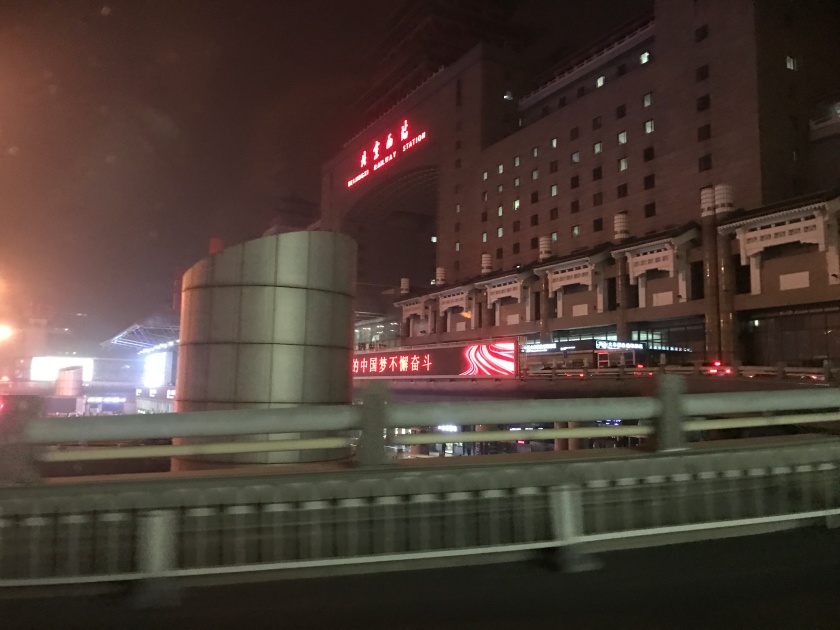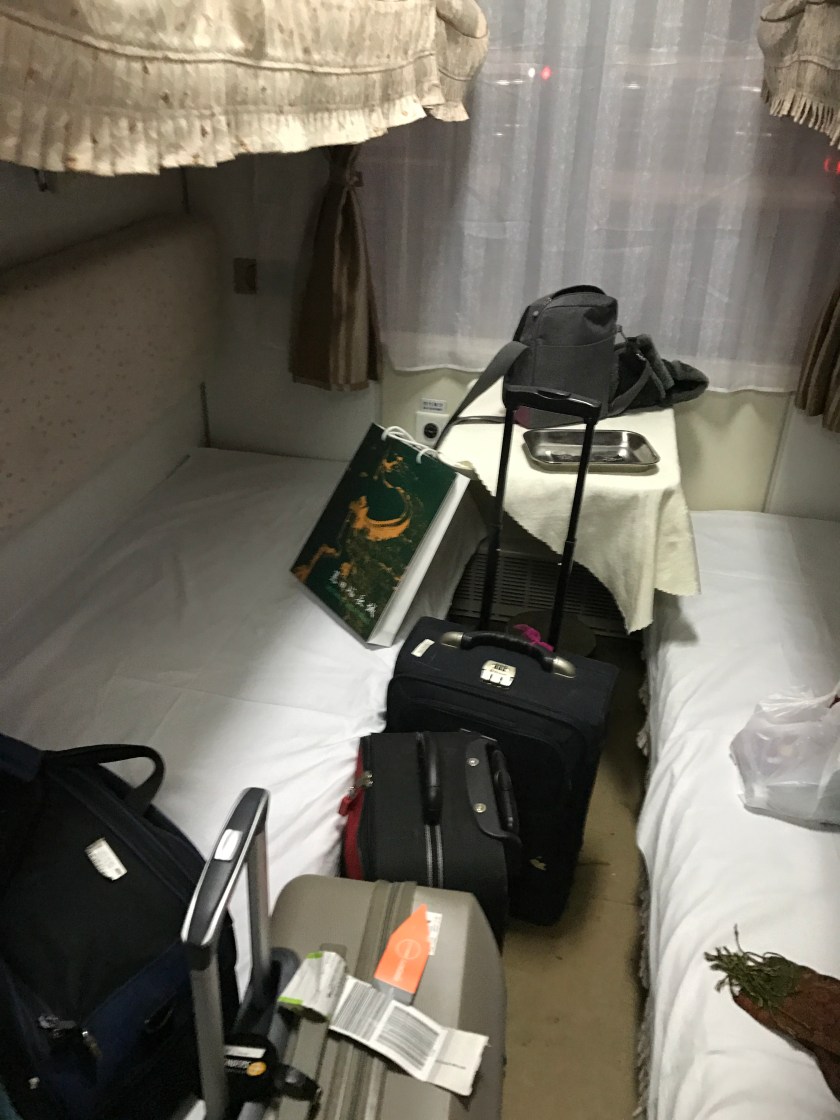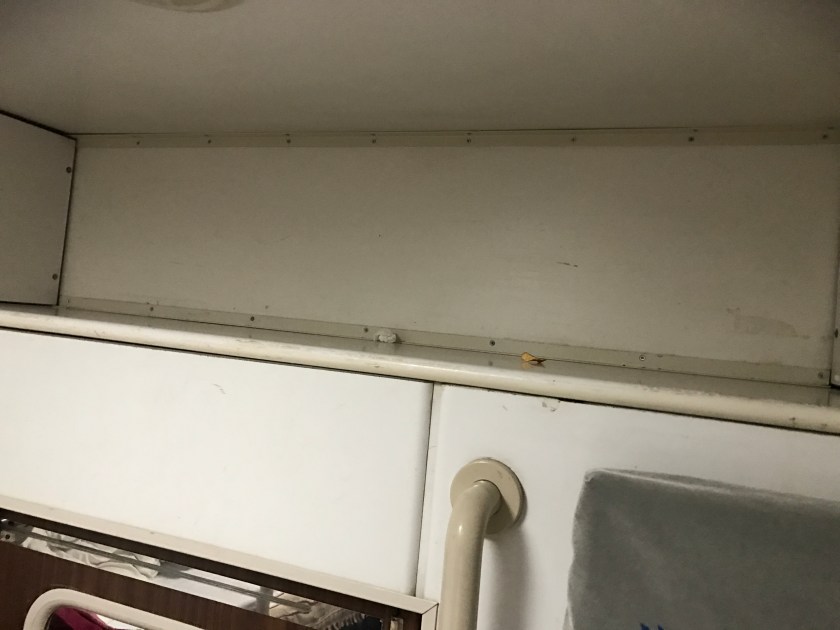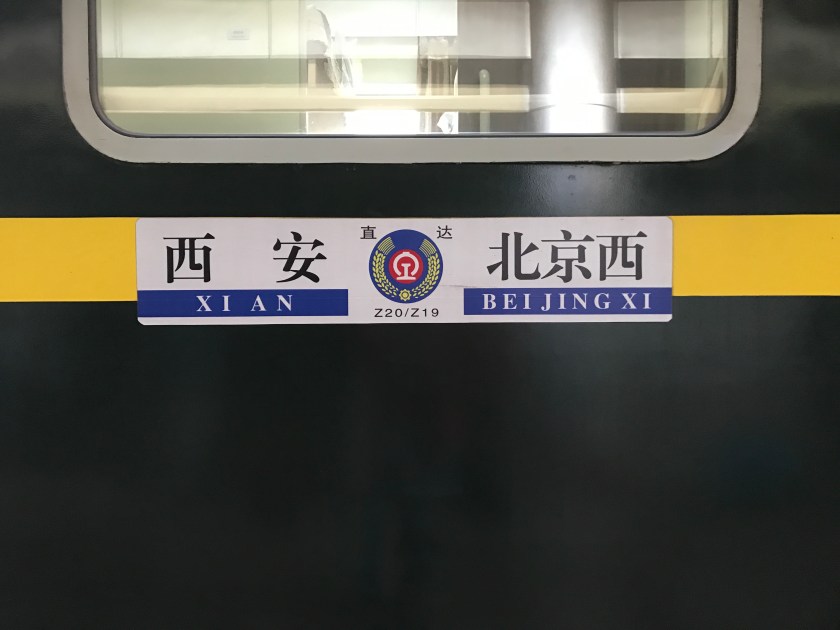On Day 3 of our China trip, we caught the sleeper train from Beijing to Xian. I was quite nervous about this leg of the journey, so I read everything I could find about taking a sleeper train in China. So in this post, I wanted to share my experience of the journey for anyone thinking of taking a similar trip.
Beijing Station and Getting On The Train
Our starting point for the journey was the Beijing Central railway station.

We had already booked the train tickets through our travel agency, The Travel China Company. Tickets are booked with your passport number, and at the entrance to the station you need to show your ticket and passport. The ticket also shows the train number, departure time, departure station and arrival station, carriage and berth number. After the document check, there is a security screening on the luggage – similar to an airport.
We next headed to the mini supermarket at the station to stock up for dinner and breakfast on the train. If you prefer a sit down meal before boarding, there are restaurants available at the station as well.
On the central station concourse, there is a departure board that show the train numbers, times, and the waiting room number for each train. (Note: The board shows the number of the waiting room, not the platform). The writing is in Chinese Kanji characters, but you can still recognise the train numbers (check your ticket) and the times.
We headed to the waiting room for our train – you need to show your ticket to enter the waiting room. There was about 40 minutes to go till departure time, but the waiting room was already full. It got very crowded as the train departure approached.

Boarding started about half an hour before the train departure time. The board in the waiting room displays the platform when the train is ready for boarding. You can get on to the platform straight from the waiting room. There is another ticket check here. Note about the queuing – There is a queue of sorts to enter the platform, but it is not as you are used in many Western countries. My tip for you here is to relax and go with the flow of things. The train won’t leave until everyone gets on it.

Then it’s down the escalator to the platform and on to the train. You need to show the ticket one more time to step on board the train.

On the Train
Each carriage has a dozen or so compartments. We were on a second class “soft sleeper” compartment with 4 berths. There are two other classes available: First class “soft sleeper” with two berths per compartment and the third class “hard sleeper” with 6 berths each without open compartments. More details about different train sleeper train classes in China here.



There is also luggage space at the top, but to get to this, you have to lift the luggage above your head, not dissimilar to putting your luggage in an overhead cabin on a plane.

Good, clean bedding (pillow, sheet and duvet) and slippers are also provided.
Getting to the top bunk is not impossible, but, the foot hold and the hand hold takes a fair bit of reaching. So if you have knee or back problems, the top bunks are best avoided.
The compartment is lockable from the inside. At each bunk, there is a coat hanger and a small rack, so you can keep your valuables nearby when you go to sleep. There was also a small TV screen on each bunk, but these were not working.

Each compartment only has one charging point, which is only really accessible to one of the bottom bunks. There are extra charging points available in the corridor.

Boiling water is provided from a tap at the end of each carriage.

The guard came and checked each compartment before departure, (presumably to make sure only the passengers were on board).
Soon after we set off, the train attendant came to take tea/coffee orders for the next morning (see more about this below).
A number of the other passengers in the carriage changed to their pajamas and settled in as soon as the train started moving. We on the other hand, laid out our dinner on the small table and had a mini-feast.

Each carriage has a washroom with 3 sinks for washing and a separate toilet. The toilet was in good condition for most of the journey. There are no showering facilities.

Soon, we had settled in, and started to drift off to sleep. The train vibrated quite a lot, but we managed to get several hours of sleep. The only thing that bothered us was the ventilation system. The ventilation of the different compartments are are interlinked, so when someone in another compartment smokes, this seeps through to the rest. Smoking is prevalent in China, and smoking bans are a rarity. The compartment has no operable windows, so the only way to get the smoke out quickly is to open the door. Not ideal when you are trying to sleep.
We were up early the next morning about, 6 a.m. This was a good thing, as we managed to beat the rush for using the washrooms and toilet. Then we watched dawn break over the countryside, as we approached Xian.

Our tea arrived 45 minutes before arrival in Xian. They cost 10 Yuan each (£1.20), but the coffee was undrinkable and the tea was green tea (understandable in China). Luckily, we had a few “instant” teas that we bought from the station supermarket and you can make your own tea with the hot water from the carriage. These cost 5 Yuan, and tasted much better.




The toilets and washrooms were locked about 30 minutes before arrival, and there was also a rubbish collection. Before long, we were alighting in Xian, ready for Day 4.

Tips for Overnight Train Travel in China:
- If travelling in 2-berth or 4 berth compartments, book the entire compartment. It will cost more, but I felt that the extra money would be worth it, as it gives you more privacy as well as more space for your luggage.
- Take an eye mask, face-mask and ear plugs. The lights on stations that the train goes past are very bright. Unless you have the curtains completely closed, it will disturb your sleep, so an eye mask is useful to block out the light. A face mask would be handy to reduce any unpleasant smells including smoking (see above). Ear plugs of course, I find are useful to fall asleep anywhere.
- In the morning get up early to use bathroom and washing before others, as it can get busy.
- Take toilet roll and wet wipes. There are none available on the train.
- Travel light. Luggage space inside the compartment is limited. There’s no space inside for large suitcases (although, these can be left in the corridor if needed). Airline carry on bag size is the best if you can manage it. I also packed my overnight essentials into to a smaller bag so that I didn’t have to keep reaching into the our largerr suitcases.
- Take sufficient bottled water for the journey. Hot water is available on the train, but the rest of the tap water is not drinkable.
- Take some food with you. The trains sometimes have a restaurant car, but this is not guaranteed.
- Don’t order tea/coffee from the train. Instead, get a few instant teas from the station supermarket and you can make your own with the hot water from the carriage. These cost 5 Yuan, and taste much better (and you can have many different flavors, and even bubble tea 🙂 )
This train journey was the part that I was most nervous about in our entire trip, but it went without a hitch. The train was on time and reasonably comfortable. Everything provided for us on the train (bedding, slippers etc.) was good quality and the facilities were reasonably clean. Overall, I can say it’s a time and cost effective way to travel the vast distances in China. By travelling whilst you sleep, you preserve more of the day for sight-seeing, as well as saving the cost of a hotel for a night.
And of course, if this post hasn’t convinced you that overnight sleeper train travel is for you, there is a high speed train from Beijing to Xian. This takes 5/6 hours (depending on which train you take), and at the time of writing cost 516 Yuan for a second class ticket (compared to 399 Yuan for a the 4 berth sleeper train). If you are wondering what travel on a high speed train in China is like, read my post here.
Have you taken the sleeper train in China? Or anywhere else? How does the experience compare? Leave a comment below and let me know.




Thank you for this. It reminded me of a trip to China I did in 1996. We flew into Beijing and then took the train to Xi’an, Chengdu and somewhere in between: I can’t remember the name. I think it was Luoyang, from where we took buses to get to the Shaolin temple and the Buddhist caves. It was a very memorable trip. I remember going in a 4 berth soft sleeper with my friend (it looked almost identical to yours!) and we ended up sharing with two elderly ladies from England, who were regular travellers on Chinese trains. They taught us many card games and it made the time pass very quickly. Our entire carriage was empty as none of the locals could afford the soft sleeper at that time. I can’t remember what we ate or drank but memories of people last a very long time! It was super helpful hearing your account. Maybe one day soon I’ll go and do it all again… Who knows…
LikeLiked by 1 person
Great post! I find post like these so helpful when you are trying to plan a trip, so thanks for sharing your experiences. Too bad about the smoking though – I am very sensitive to cigarette smoke smells, so I probably would have been frustrated with that the whole journey long!
LikeLiked by 1 person
Thanks Bryna. Yes, the smoke was annoying, but it dissipated after while but didn’t last the whole night – although that could have been a real possibility! Thanks for stopping by!
LikeLike
This is very helpful information. I’m going to be in China this fall and I may decide to ride the train. For now my itinerary is not very clear, but I will surely start in Beijing. #TheWeeklyPostcard
LikeLiked by 1 person
Hope you have a great time there. There’s so much to see, especially in Beijing.
LikeLike
I’m most nervous about toilets as I have heard of horror stories of dirty toilets/washrooms in China. Thanks for sharing with us about smoke creeping through the vents – oh that’s not pleasant – but yeah, smoking is very common in China, unfortunately. Good tips! 🙂
LikeLiked by 1 person
Thanks for stopping by Kathleen!
LikeLike
My husband travels to China every few weeks (is there now actually) and he has been on these sleeper trains. I haven’t, so it was super seeing some photos of the trains. #TheWeeklyPostcard
LikeLiked by 1 person
🙂 thanks for stopping by!
LikeLike
So nice to see what it’s like to take a sleep train in China! I probably would have just flown, but this looks doable! Thanks for sharing on #TheWeeklyPostcard!
LikeLiked by 1 person
Yes, the sleeper train is pretty good. Quite a cost and time effective option. Thanks for stopping by!
LikeLike
That is a relief! I would have been worried about the sleeper train too. Before reading this, I probably would have just flown between the two cities. After reading this, I think I could do it too. I am guessing it saves you a fair bit compared to flying? Thanks for sharing on #TheWeeklyPostcard.
LikeLiked by 1 person
Definitely doable. Yes, it’s cheaper than flying, plus it saves you the cost of a hotel for a night. Thanks for stopping by!
LikeLiked by 1 person